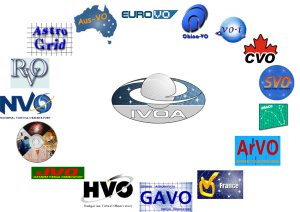 The idea of the Virtual Observatory is that the world's astronomical data should be transparently useable, in just the same way that the World Wide Web makes documents all over the world feel part of a single interlinked system. Just like the Web, the aim is that it should feel like all those datasets are just inside your computer, ready to use. In fact, as there are more and more astronomical datasets coming online every year, we risk a Tower of Babel unless we act to standardise them ... Of course we want to do more than just look at datasets; we want our applications software to understand any data it comes across. Software as well as data should then become increasingly standardised.
The idea of the Virtual Observatory is that the world's astronomical data should be transparently useable, in just the same way that the World Wide Web makes documents all over the world feel part of a single interlinked system. Just like the Web, the aim is that it should feel like all those datasets are just inside your computer, ready to use. In fact, as there are more and more astronomical datasets coming online every year, we risk a Tower of Babel unless we act to standardise them ... Of course we want to do more than just look at datasets; we want our applications software to understand any data it comes across. Software as well as data should then become increasingly standardised.
At the same time as we wish the world of data to become transparent, it is becoming harder to get at the data. The volume of astronomical data is growing alarmingly quickly. While storage, CPU, and backbone internet bandwidth are growing at Moore's law rate, the infamous "last mile" problem means that the rate at which you can download data is much less impressive, and searching through a Terabyte database on your PC can take all day. The "download and then do it yourself" model has to change; instead data services as well as actual data will increasingly be provided by expert centres, while users find and consume these services. The motto is "download the results not the data".
The international scene
 The continuing improvement of internet technologies - such as TCP/IP, Java, XML, SOAP and REST - makes the VO a feasible ideal. However three things have been needed on top of these underlying technologies - astronomical and technical standards; working data services; and infrastructural "glue" software. Starting around 2000, several projects around the world starting working on these things, and came together in a body called the International Virtual Observatory Alliance (IVOA). The IVOA agrees technical and astronomical standards which are then passed on to the IAU for ratification; it also shares ideas and technology between partners. AstroGrid was a founding member of the IVOA. In Europe, the main organisations, including AstroGrid, came together to form a close alliance called Euro-VO
The continuing improvement of internet technologies - such as TCP/IP, Java, XML, SOAP and REST - makes the VO a feasible ideal. However three things have been needed on top of these underlying technologies - astronomical and technical standards; working data services; and infrastructural "glue" software. Starting around 2000, several projects around the world starting working on these things, and came together in a body called the International Virtual Observatory Alliance (IVOA). The IVOA agrees technical and astronomical standards which are then passed on to the IAU for ratification; it also shares ideas and technology between partners. AstroGrid was a founding member of the IVOA. In Europe, the main organisations, including AstroGrid, came together to form a close alliance called Euro-VO  , which collaborates on technology, on data centre deployment, and on support of the user community. Although AstroGrid runs its own operational services, we make sure that our software interoperates with that of Euro-VO partners.
, which collaborates on technology, on data centre deployment, and on support of the user community. Although AstroGrid runs its own operational services, we make sure that our software interoperates with that of Euro-VO partners.
VO resources...
In the VO world there is the idea of a resource, which can be almost anything - a repository of information, a library of spectra, a queryable database, an application you can invoke with specified parameters, etc - as long as it is set up, and advertises its wares, in a standardised way. One of the key jobs of the IVOA is agreeing protocols for "advertising" resources, e.g. for stating "You can get images from me; this is the address; I accept such and such parameters, and return such and such". What's needed next is a Registry i.e. a kind of yellow pages for such resources, so people or software can find resources and understand what they do. There are now several such VO registries round the world and they "harvest" from each other so as to stay up to date. [Artists impression of Leonid meteor shower - Shigemi Numazawa, Japan Planetarium Laboratory; courtesy Sky and Telescope]

... and what to do with them
If data are returned by a resource in a standard format - such as a table in "VOtable" format - then applications tools can do something sensible with the data and scientific analysis can start. Also however, applications share material by using an agreed "messaging" protocol. If the resource is a remotely invokeable application, it likewise should share its inputs and outputs in a standardised way. This enables VO services to be strung together in a standardised way, known as a "workflow" - and opens the way for "VO scripting".
Two more ideas are needed. The first is the idea of a distributed storage service, so that files and data can be stored in situ rather than downloaded to a user's own disk. AstroGrid have been running such a service for several years, originally called MySpace. (Yes, we thought of the name first, but never registered it !). The protocols for doing this are now standardised and there is an international VOSpace. The second idea is that of registering in a community. Your identification is then stored and passed round in a way standardised in the VO world, so that you can have access to proprietary data as appropriate, and don't have to remember thirty seven different passwords. (The single sign on idea.) It is also how you sign on to your VOSpace account, and as this becomes increasingly normal internationally, will be a way you can share data and files with specified individuals and groups of individuals.